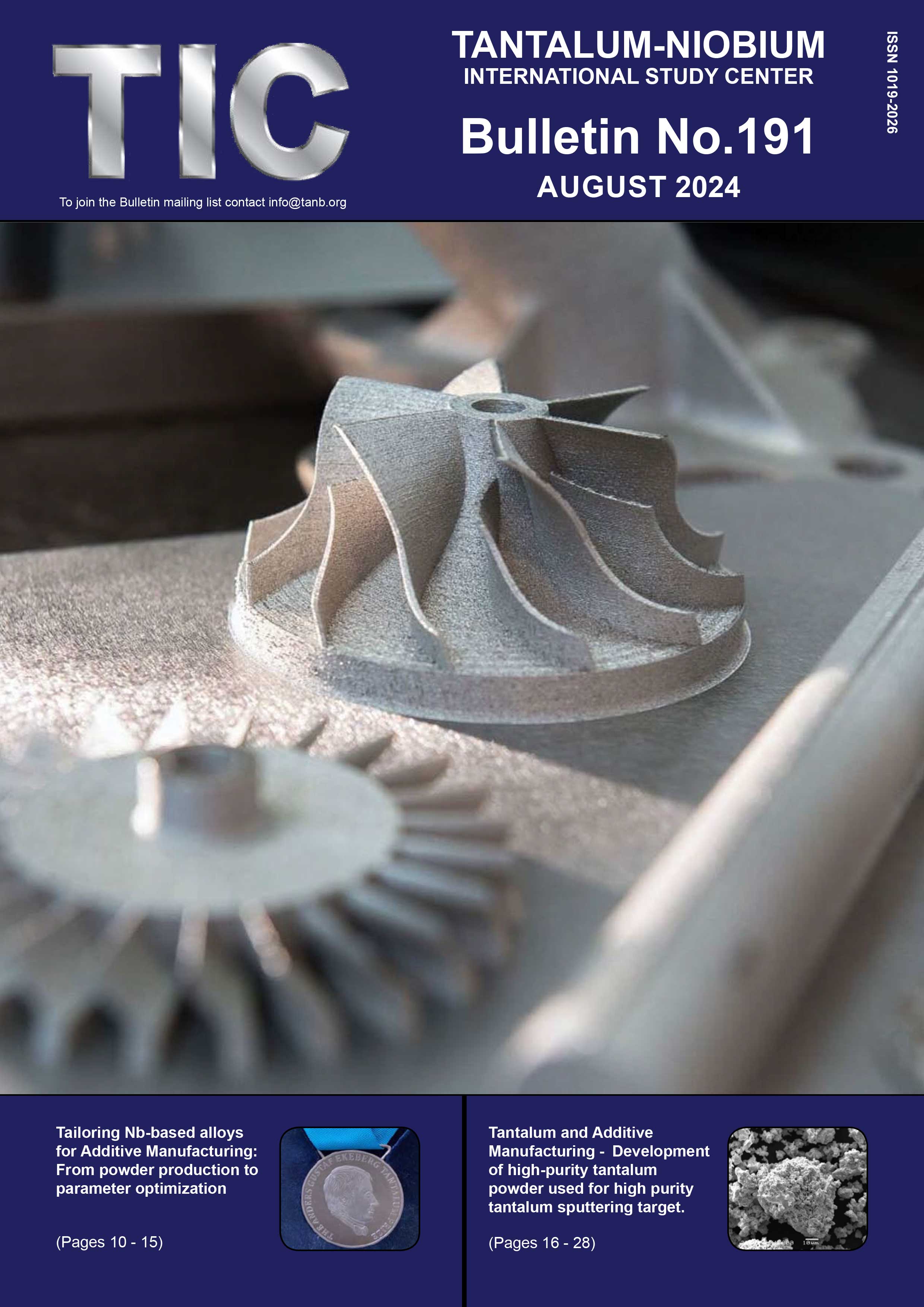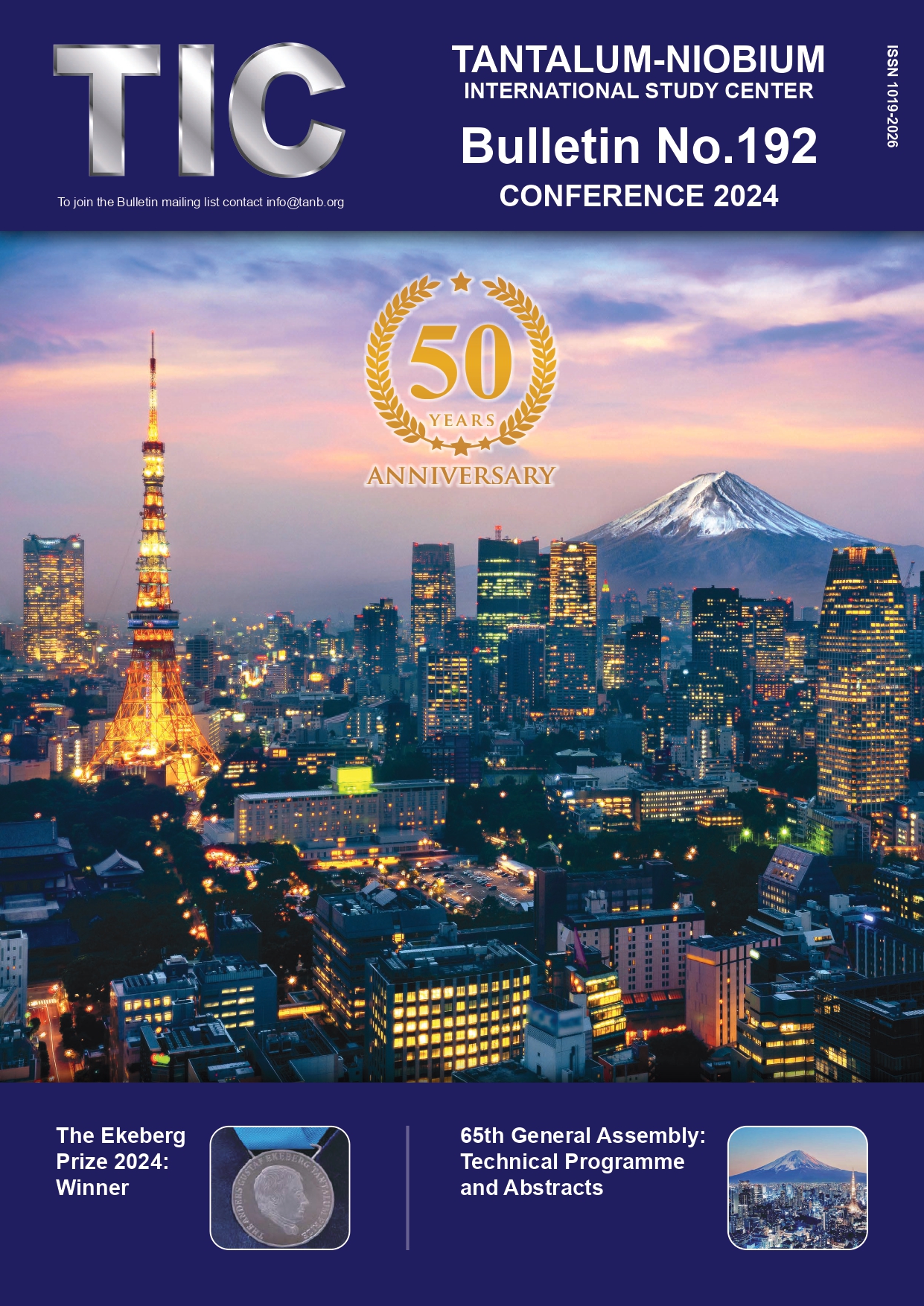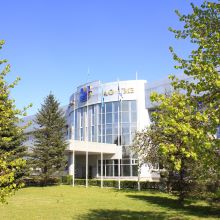Ekeberg Prize 2021 - Shortlist
.png)
Recognising excellence in tantalum research and innovation
The Anders Gustaf Ekeberg Tantalum Prize ('Ekeberg Prize') is awarded annually by the T.I.C. for excellence in tantalum research and innovation and the new shortlist for the 2021 award shows that the level of interest in element #73 remains as high as ever*.
The Ekeberg Prize was established by the T.I.C. in 2017 to increase awareness of the many unique properties of tantalum products and the applications in which they excel. To date the Ekeberg Prize has been awarded for outstanding work on the subjects of tantalum capacitors (2018, Dr Yuri Freeman), additive manufacturing (2019, Nicolas Soro et al) and recycling tantalum by solvent extraction (2020, Prof. Jason Love et al).
Technology-driven innovations will ensure the long-term future of the tantalum market and with so many potential new or embryonic applications in development there is every reason for optimism.
This year, the seven publications on the shortlist show the great versatility of tantalum in a number of cutting edge applications and new techniques (see full abstracts in Bulletin No.186):
- Tantalum-titanium alloys for additive manufacturing applications
- Microwave preparation of polyoxoniobates and polyoxotantalates
- An examination of why it is so difficult to cut tantalum metal
- Integrating tantalum pentoxide waveguides into niobium-titanium nitride superconducting nanowires
- Using oxalic-nitric acid to dissolve and separate niobium and tantalum
- Ultrahigh thermal conductivity of θ-phase tantalum nitride
- Creating homostructural Ta3N5nanotube/nanoparticle photoanodes for water splitting
The winner will be chosen by the independent panel of experts and the Prize medal, made from pure tantalum metal, will be awarded at the T.I.C.’s 62nd General Assembly (annual conference) in London, UK, in November 2021. The T.I.C.’s conference is the largest annual gathering of tantalum and niobium industry leaders, with delegates from every sector of the global industry.
Ekeberg Prize Shortlist 2021
|
Microwave synthesis of alkali-free hexaniobate, decaniobate, and hexatantalate polyoxometalate ions |
||
| Authors: |
Mark A. Rambaran, Magda Pascual-Borràs and C. André Ohlin |
|
| Organisations: |
Department of Chemistry, Umeå University, Umeå, Sweden |
|
| Full article at: |
European Journal of Inorganic Chemistry, Volume 2019, Issue 35, pages 3913-3918 |
|
|
https://chemistry-europe.onlinelibrary.wiley.com/doi/abs/10.1002/ejic.201900750 |
||
|
Osteogenic potential of additively manufactured TiTa alloys |
||
|
Authors: |
Erin G. Brodie1,2*, Kye J. Robinson3, Elizabeth Sigston4,5, Andrey Molotnikov1,2,6, Jessica E. Frith1* |
|
|
Organisations: |
1. Department of Materials Science and Engineering, Monash University, Clayton, VIC, 3800, Australia |
|
|
2. Monash Centre for Additive Manufacturing (MCAM), 11 Normanby Road, Nottinghill, VIC, 3168, Australia |
||
|
3. Department of Inorganic and Analytical Chemistry, University of Geneva, CH-1211 Geneva, Switzerland |
||
|
4. Department of Surgery, School of Clinical Sciences at Monash Health, Monash University, Clayton, VIC, 3800, Australia |
||
|
5. Department of Otolaryngology, Head and Neck Surgery, Monash Health, Clayton, VIC, 3168, Australia |
||
|
6. RMIT Centre for Additive Manufacturing, School of Engineering, RMIT University, Melbourne, Australia |
||
|
Full article at: |
ACS Appl. Bio Mater. 2021, 4, 1003−1014 |
|
|
Cutting of tantalum: why it is so difficult and what can be done about it |
||
|
Authors: |
Jason M. Davisab, Mojib Saeia, Debapriya Pinaki Mohantya, Anirudh Udupaa, Tatsuya Sugiharac, Srinivasan Chandrasekara |
|
|
Organisations: |
A. Center for Materials Processing and Tribology, Purdue University, West Lafayette, IN, 47907-2023, USA |
|
|
B. Special Warfare and Expeditionary Systems Department, Naval Surface Warfare Center, Crane Division, Crane, IN, 47552, USA |
||
|
C. Department of Mechanical Engineering, Osaka University, Suita, Osaka, 565-0871, Japan |
||
|
Full article at: |
International Journal of Machine Tools and Manufacture, Volume 157, October 2020, 103607; |
|
|
Superconducting nanowire single-photon detectors integrated with tantalum pentoxide waveguides |
||
|
Authors: |
Martin A. Wolffabc, Simon Vogelabc, Lukas Splitthoffabc, Carsten Schuckabc |
|
|
Organisations: |
A. Institute of Physics, University of Münster, Wilhelm-Klemm-Str. 10, 48149, Münster, Germany |
|
|
B. CeNTech – Center for Nanotechnology, Heisenbergstr. 11, 48149, Münster, Germany |
||
|
C. SoN – Center for Soft Nanoscience, Busso-Peus-Straße 10, 48149, Münster, Germany |
||
|
Full article at: |
Scientific Reports volume 10, Article number: 17170 (2020) |
|
|
Homostructural Ta3N5 nanotube/nanoparticle photoanodes for highly efficient solar-driven water splitting |
||
|
Authors: |
Xian Zhanga,b, Huilin Guoa, Guojun Dongb, Yajun Zhangb, Gongxuan Lub and Yingpu Bib,c |
|
|
Organisations: |
A. Key Laboratory of Synthetic and Natural Functional Molecule Chemistry (Ministry of Education), College of Chemistry and Materials Science, Northwest University, Xi'an, 710127, PR China |
|
|
B. State Key Laboratory for Oxo Synthesis & Selective Oxidation, Lanzhou Institute of Chemical Physics, CAS, Lanzhou, 730000, PR China |
||
|
C. Dalian National Laboratory for Clean Energy, CAS, Dalian, 116023, PR China |
||
|
Full article at: |
Applied Catalysis B: Environmental, Volume 277 |
|
|
https://www.sciencedirect.com/science/article/abs/pii/S0926337320306329 |
||
|
Ultrahigh thermal conductivity of θ-phase tantalum nitride |
||
|
Authors: |
Ashis Kundu1,2, Xiaolong Yang1,2, Jinlong Ma1,4, Tianli Feng5, Jesús Carrete3, Xiulin Ruan6, Georg K. H. Madsen3, Wu Li1 |
|
|
Organisations: |
1. Institute for Advanced Study, Shenzhen University, Shenzhen 518060, China |
|
|
2. College of Physics and Optoelectronic Engineering, Shenzhen University, Shenzhen 518060, China |
||
|
3. Institute of Materials Chemistry, TU Wien, 1060 Vienna, Austria |
||
|
4. School of Energy and Power Engineering, Huazhong University of Science and Technology, Wuhan 430074, China |
||
|
5. Department of Mechanical Engineering, University of Utah, Salt Lake City, Utah 84112, USA |
||
|
6. School of Mechanical Engineering and the Birck Nanotechnology Center, Purdue University, West Lafayette, Indiana 47907-2088, USA |
||
|
Full article at: |
Phys. Rev. Lett. 126, 115901 (2021) |
|
|
https://journals.aps.org/prl/abstract/10.1103/PhysRevLett.126.115901 |
||
|
Niobium and tantalum processing in oxalic-nitric media: Nb2O5·nH2O and Ta2O5·nH2O precipitation with oxalates and nitrates recycling |
||
|
Authors: |
Gauthier J.-P. Deblondeabc, David Bengiob, Denis Beltramib, Sarah Bélairb, Gérard Cotea, Alexandre Chagnesd |
|
|
Organisations: |
A. PSL Research University, Chimie ParisTech – CNRS, Institut de Recherche de Chimie Paris, 11 rue Pierre et Marie Curie, 75005 Paris, France |
|
|
B. ERAMET IDEAS, 1 avenue Albert Einstein, 78193 Trappes, France |
||
|
C. Lawrence Berkeley National Laboratory, Chemical Sciences Division, Berkeley, CA 94720, USA D. Université de Lorraine, CNRS, GeoRessources, 54000 Nancy, France |
||
|
Full article at: |
Separation and Purification Technology, Volume 226, 1 November 2019, Pages 209-217; |
|
|
https://www.sciencedirect.com/science/article/abs/pii/S1383586619320817?via%3Dihub |
||
About the Ekeberg Prize
The Ekeberg Prize is the annual award that recognizes excellence in published research about the element tantalum (Ta). The long-term future of the tantalum market will depend on technology-driven innovations and a new prize dedicated to this rare and critical element will encourage research and development. The Ekeberg Prize increases awareness of the many unique properties of tantalum products and the applications in which they excel.
A T.I.C. spokesman said “Winners of the Anders Gustaf Ekeberg Tantalum Prize are acknowledged as true leaders in this field.” Further information is available at https://www.tanb.org/view/prize.
About Dr Anders Gustaf Ekeberg
Born in 1767, Anders Gustaf Ekeberg was a Swedish scientist, mathematician, and poet. He became a professor at Uppsala University in 1794 and initially made his name by developing advanced analytical techniques and by proposing Swedish names for the common chemical elements according to the principles set out by the "father of modern chemistry" Antoine-Laurent de Lavoisier. Ekeberg discovered the oxide of tantalum in 1802, isolating it from samples of two different minerals. According to Ekeberg’s friend, the chemist Jacob Berzelius, Ekeberg chose the name ’tantalum’ partly to reflect the difficulties that he had experienced in reacting the new element with common acids and partly out of his passion for ancient Greek literature. Tantalus was a demi-god who killed and cooked his son, Pelops, and as punishment was condemned to stand in a pool of water beneath a fruit tree with low branches, with the fruit ever eluding his grasp, and the water always receding before he could take a drink.





